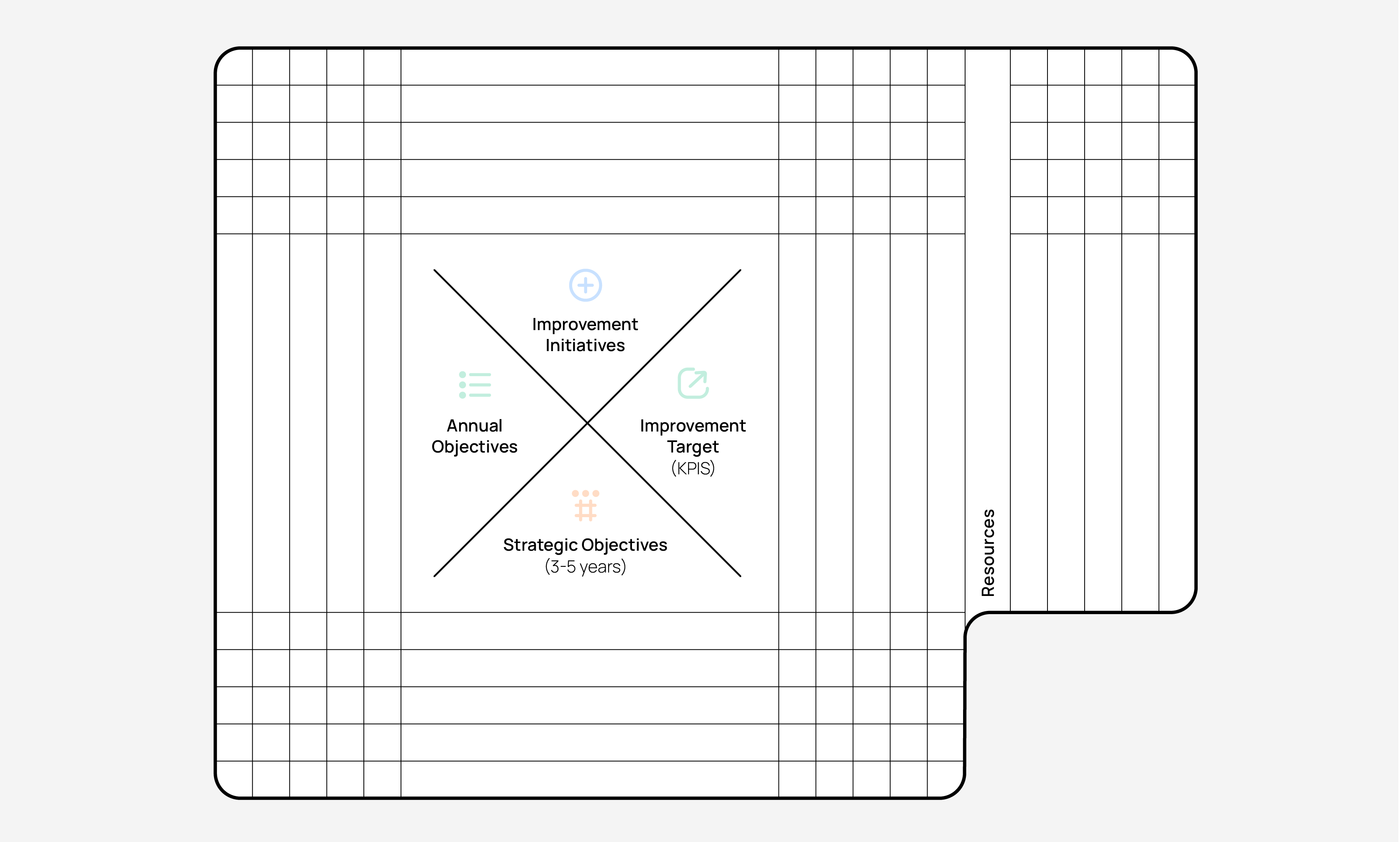Hoshin Kanri
Hoshin Kanri is a collaborative approach to planning that aligns an organisation’s activities with its long-term objectives.
Hoshin Kanri has a unique engagement process called ‘catchball’ which is a collaborative and iterative approach to planning that involves the back-and-forth exchange of ideas, goals, and plans between different levels of management and teams to refine and agree upon strategic objectives and action plans.
Key concepts in Hoshin Kanri include:
Strategic objectives: Significant, transformative goals that drive the organisation towards its long-term vision. These objectives are ambitious, aiming to achieve substantial improvements or innovations.
Example: Develop a revolutionary battery technology that doubles the driving range of electric vehicles within three years
Annual objectives: Shorter-term goals that contribute to the achievement of strategic objectives within a one-year timeframe.
Example: ‘Increase production efficiency by 15% in the next 12 months
Catchball: Refining and agreeing objectives and plans by passing objectives and plans back and forth—like a ball in a game—between leaders and their teams.
KPIs (Key Performance Indicators): Specific, quantifiable measures used to track progress toward achieving strategic and annual objectives. KPIs provide clear benchmarks for success and help monitor whether the organisation is on track to meet its goals.
Example: Increase customer satisfaction score by 10% within one year
Initiatives: Work designed to achieve the objectives.
Example: Launch a service digitisation programme
The results
- A visual ‘plan on a page’ that supports shared understanding of the organisations objectives and key actions
- Increased visibility and engagement with expected outcomes

When to use it
Strategic Execution Planning: When seeking to translate an already defined strategy into an actionable plan
Business Planning: When undertaking annual financial planning
Change Management: When seeking to align efforts through periods of organisational change
Strengths
Simple and visual output
Works well with strategy formulation tools
Engaging
Weaknesses
Can be time consuming
May lead to over-planning
Requires strong leadership
How to use it?
What do I need to start?
- A clear vision and strategy
- Insights on internal performance
- Leadership buy-in
How to use it?
Who to involve?
Hoshin Kanri is designed to be developed collaboratively. Include:
- Decision makers who can set the strategic direction
- Leaders from across the organisation who are responsible for delivering against the strategic direction
- Influential individual contributors who can support implementation of plans
Step by step
1
Define strategic objectives
Strategic objectives are generally defined by the executive leadership team.
Brainstorm strategic objectives
Brainstorm potential strategic objectives.
Encourage ‘out of the box’ thinking. Ask questions like:
- ‘What objective could drive significant change and innovation?
- How can we challenge conventional thinking ?
- What if we completely reimagined our approach to [specific aspect]—what objectives would emerge?
- If we had no limits on resources or funds, what objectives would we pursue?
- In what unexpected ways could we redefine success for our organisation?
Discuss and identify objectives that are most important to focus on. Ask questions like:
- Which objectives best align with the organisation’s vision and strategy?
- Which objectives address the actual needs and opportunities of the organisation?
- Are these objectives feasible?
- Can these objectives be measured?
Prioritise
Select objectives which best align with the organisation’s strategy. It is important to only select a few key objectives to keep the organisations focus clear.
Document any assumptions and why the objectives were selected.
2
Define annual objectives
Annual objectives are generally defined by the executive leadership team, however these must have buy-in from other levels of management.
Review the strategic objectives to identify key focus areas for the upcoming year.
Brainstorm how to break down long-term objectives into smaller, actionable annual objectives. Ask questions like:
- What steps can we take to make progress towards our long-term objectives within the next year?
- What should we prioritise to focus on the most impactful initiatives for the upcoming year?
Consider the potential impacts, positive and negative, of introducing each objective.
Select a few important annual objectives and document these. Document any assumptions and why the objectives were selected.
3
Implement Catchball
Communicate downward
Communicating downward is generally done by the executive leadership team.
Share the objectives with managers across the organisation. Explain why each objective has been selected and how each objective aligns to the organisational strategy.
Gather feedback
Gathering feedback is generally done by managers across the organisation.
Review the objectives with team across organisation. Encourage feedback, including identification of potential challenges, improvements, and actions to achieve the objectives.
Collect and review feedback, and incorporate valuable suggestions into a refined plan. The refined plan may suggest alternative annual objectives and new improvement initiatives.
Negotiate and align
Discuss the revised plan, focusing on any proposed adjustments to objectives and new initiatives. Discussion is usually between the executive leaders and managers.
Work to develop a plan which delivers on strategic objectives with consideration of operational realities.
Agree on final annual objectives, improvement targets and improvement initiatives.
Repeat the process
Continue this back-and-forth until there’s consensus at all levels.
This may require 2-3 rounds of catchball, depending on the organisation’s size and complexity.
4
Finalise and document
Once alignment is achieved, document the final plan.
Ensure all levels of the organisation have access to the agreed-upon objectives and strategies.
For each agreed initiative, define:
- Who is responsible for delivery
- What the indicative start and end dates might be
- Resources required
5
Monitor and adjust
- Implement a regular review process (e.g., monthly or quarterly) to track progress.
- Use these reviews to initiate mini-catchball sessions for any necessary adjustments.
Remember, the goal of catchball is to create a collaborative, iterative process that builds buy-in from all levels of the organisation.